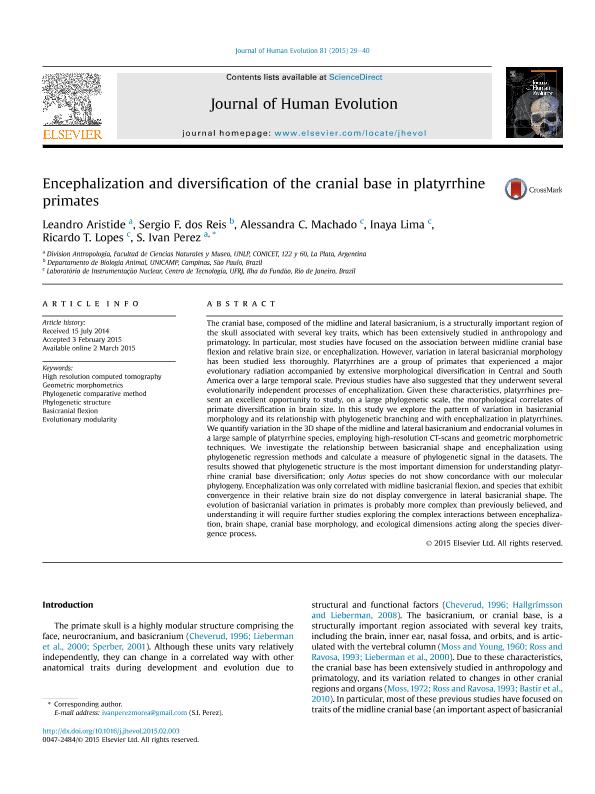Artículo
Encephalization and diversification of the cranial base in platyrrhine primates
Arístide, Leandro ; dos Reis, Sergio F.; Machado, Alessandra C.; Lima, Inaya; Lopes, Ricardo T.; Perez, Sergio Ivan
; dos Reis, Sergio F.; Machado, Alessandra C.; Lima, Inaya; Lopes, Ricardo T.; Perez, Sergio Ivan
 ; dos Reis, Sergio F.; Machado, Alessandra C.; Lima, Inaya; Lopes, Ricardo T.; Perez, Sergio Ivan
; dos Reis, Sergio F.; Machado, Alessandra C.; Lima, Inaya; Lopes, Ricardo T.; Perez, Sergio Ivan
Fecha de publicación:
04/2015
Editorial:
Academic Press Ltd - Elsevier Science Ltd
Revista:
Journal Of Human Evolution
ISSN:
0047-2484
Idioma:
Inglés
Tipo de recurso:
Artículo publicado
Clasificación temática:
Resumen
The cranial base, composed of the midline and lateral basicranium, is a structurally important region of the skull associated with several key traits, which has been extensively studied in anthropology and primatology. In particular, most studies have focused on the association between midline cranial base flexion and relative brain size, or encephalization. However, variation in lateral basicranial morphology has been studied less thoroughly. Platyrrhines are a group of primates that experienced a major evolutionary radiation accompanied by extensive morphological diversification in Central and South America over a large temporal scale. Previous studies have also suggested that they underwent several evolutionarily independent processes of encephalization. Given these characteristics, platyrrhines present an excellent opportunity to study, on a large phylogenetic scale, the morphological correlates of primate diversification in brain size. In this study we explore the pattern of variation in basicranial morphology and its relationship with phylogenetic branching and with encephalization in platyrrhines. We quantify variation in the 3D shape of the midline and lateral basicranium and endocranial volumes in a large sample of platyrrhine species, employing high-resolution CT-scans and geometric morphometric techniques. We investigate the relationship between basicranial shape and encephalization using phylogenetic regression methods and calculate a measure of phylogenetic signal in the datasets. The results showed that phylogenetic structure is the most important dimension for understanding platyrrhine cranial base diversification; only Aotus species do not show concordance with our molecular phylogeny. Encephalization was only correlated with midline basicranial flexion, and species that exhibit convergence in their relative brain size do not display convergence in lateral basicranial shape. The evolution of basicranial variation in primates is probably more complex than previously believed, and understanding it will require further studies exploring the complex interactions between encephalization, brain shape, cranial base morphology, and ecological dimensions acting along the species divergence process.
Archivos asociados
Licencia
Identificadores
Colecciones
Articulos(CCT - LA PLATA)
Articulos de CTRO.CIENTIFICO TECNOL.CONICET - LA PLATA
Articulos de CTRO.CIENTIFICO TECNOL.CONICET - LA PLATA
Citación
Arístide, Leandro; dos Reis, Sergio F.; Machado, Alessandra C.; Lima, Inaya; Lopes, Ricardo T.; et al.; Encephalization and diversification of the cranial base in platyrrhine primates; Academic Press Ltd - Elsevier Science Ltd; Journal Of Human Evolution; 81; 4-2015; 29-40
Compartir
Altmétricas



